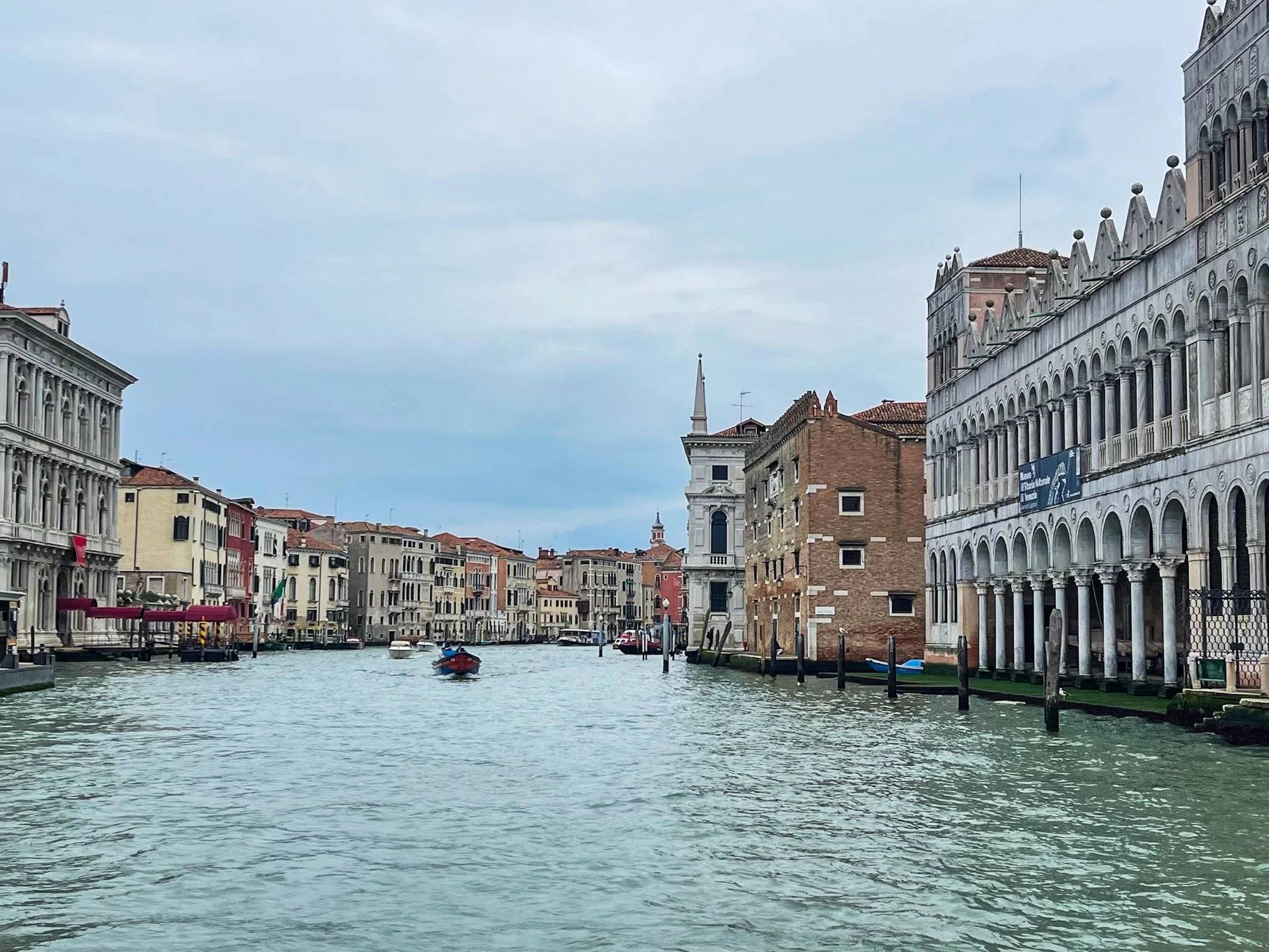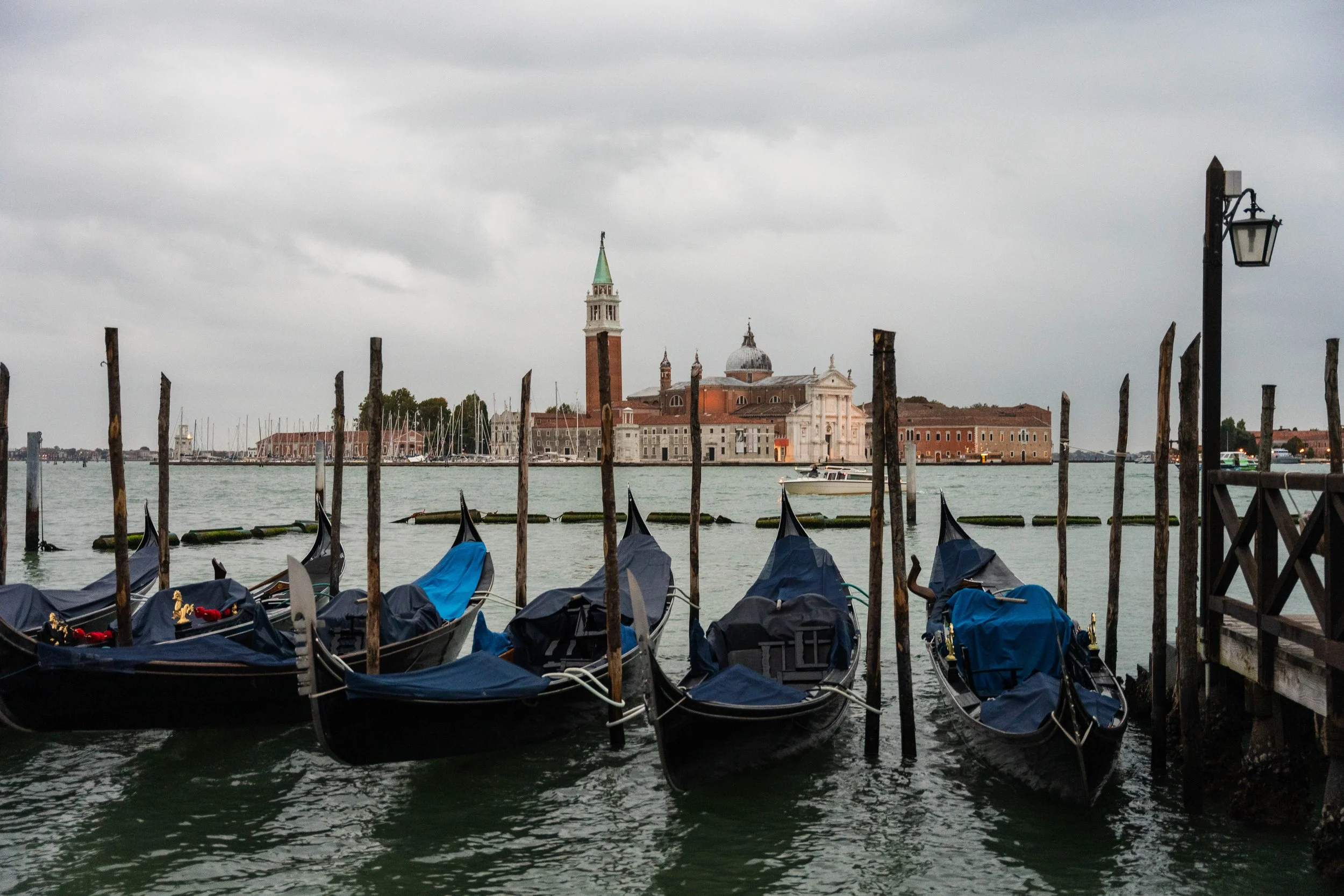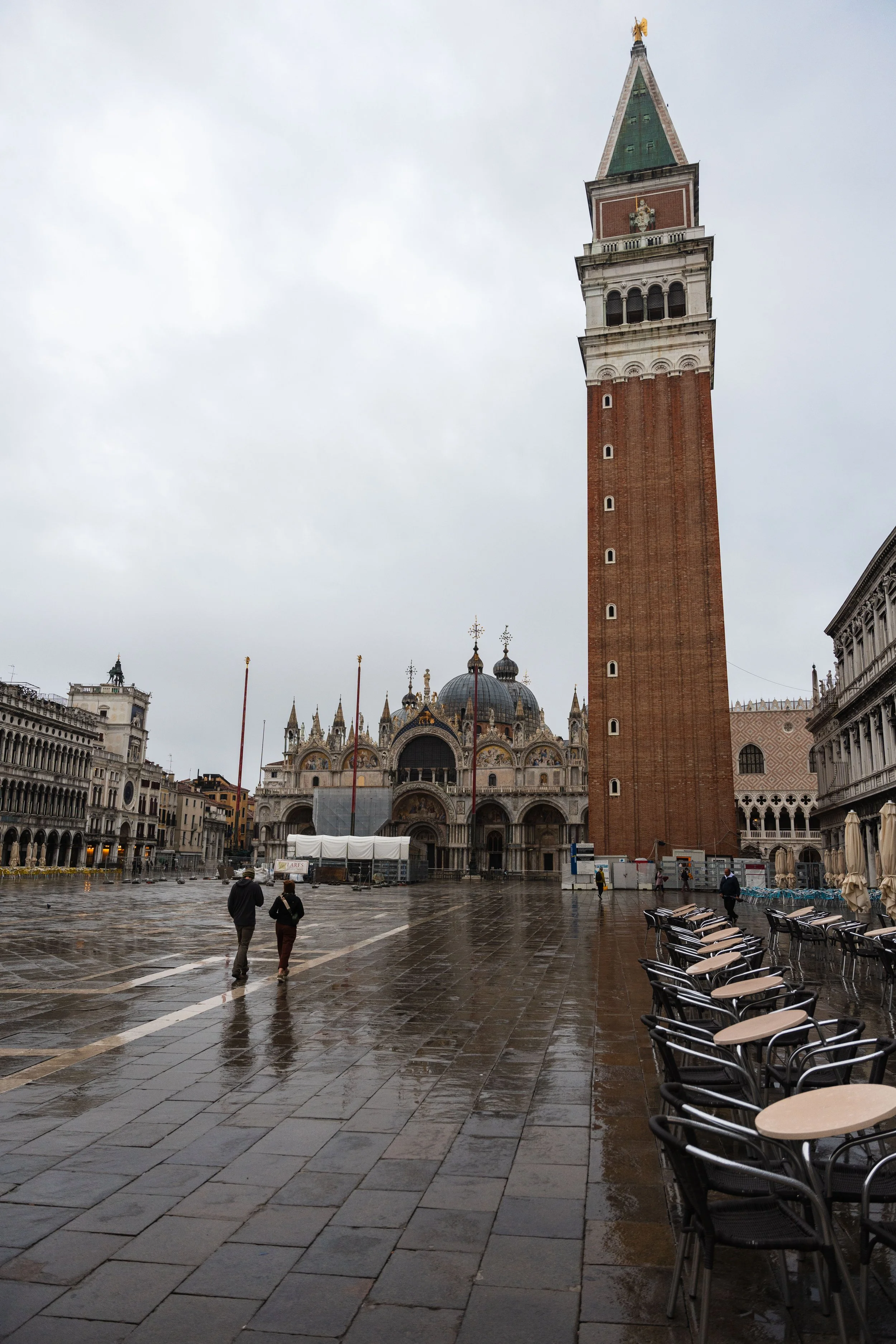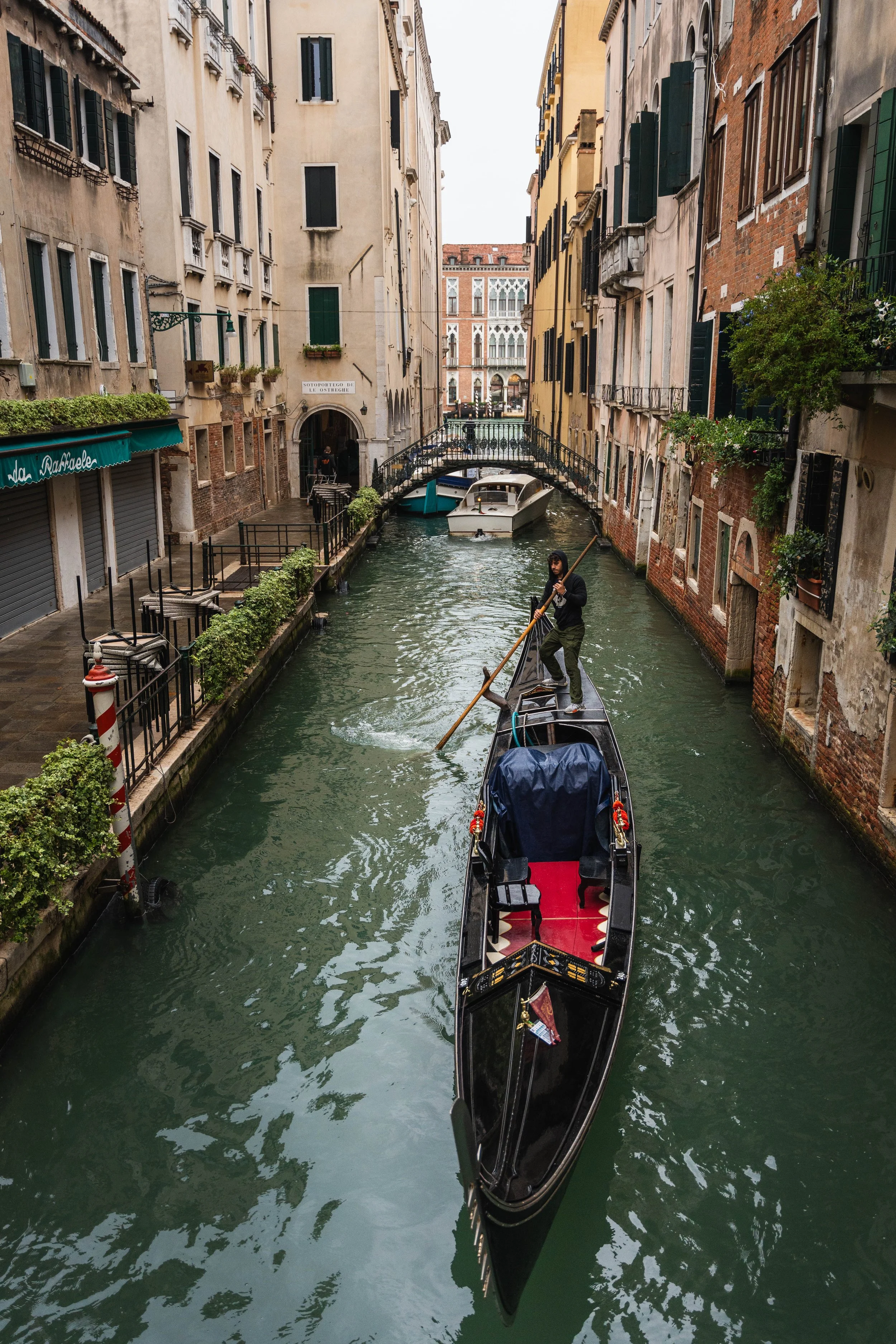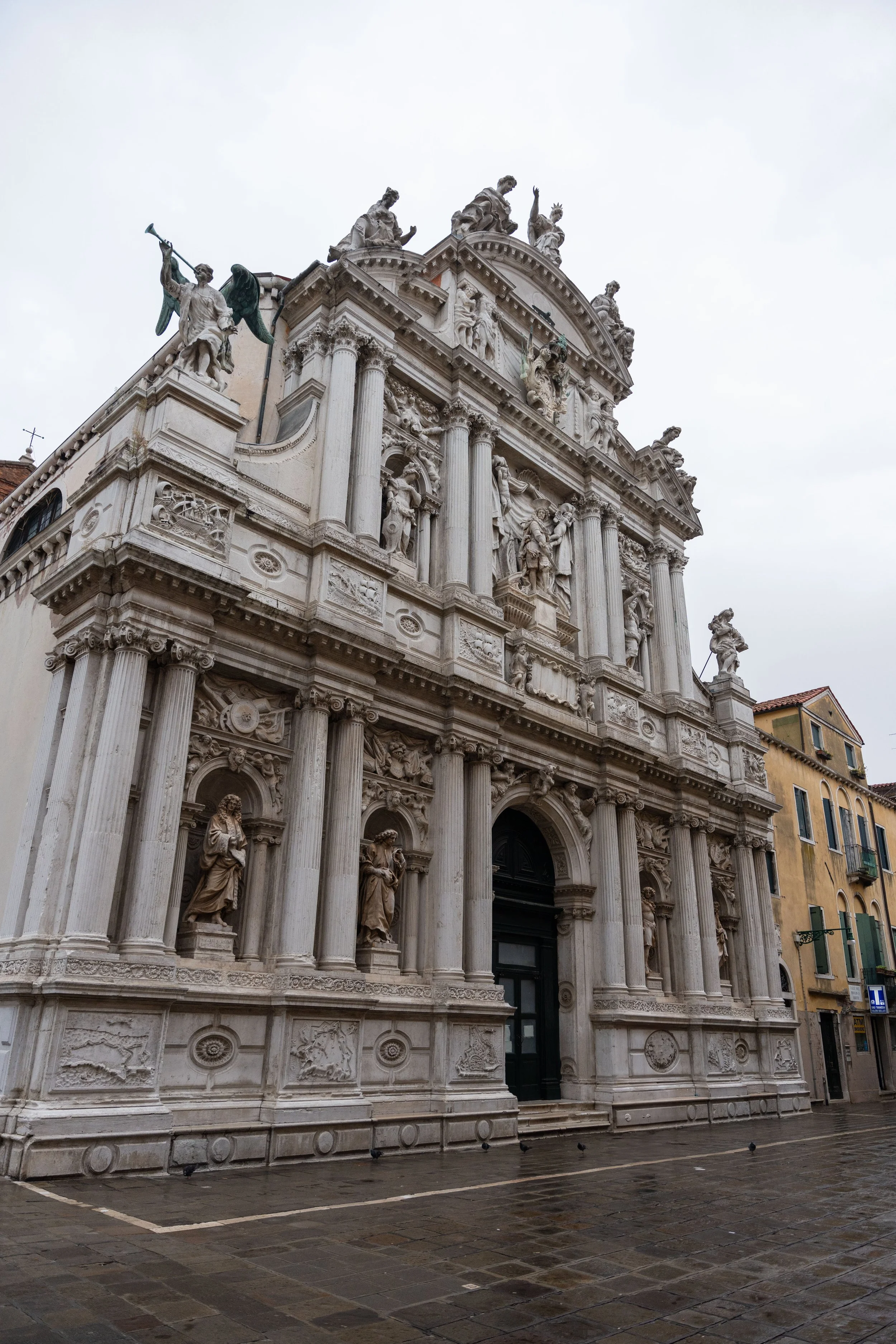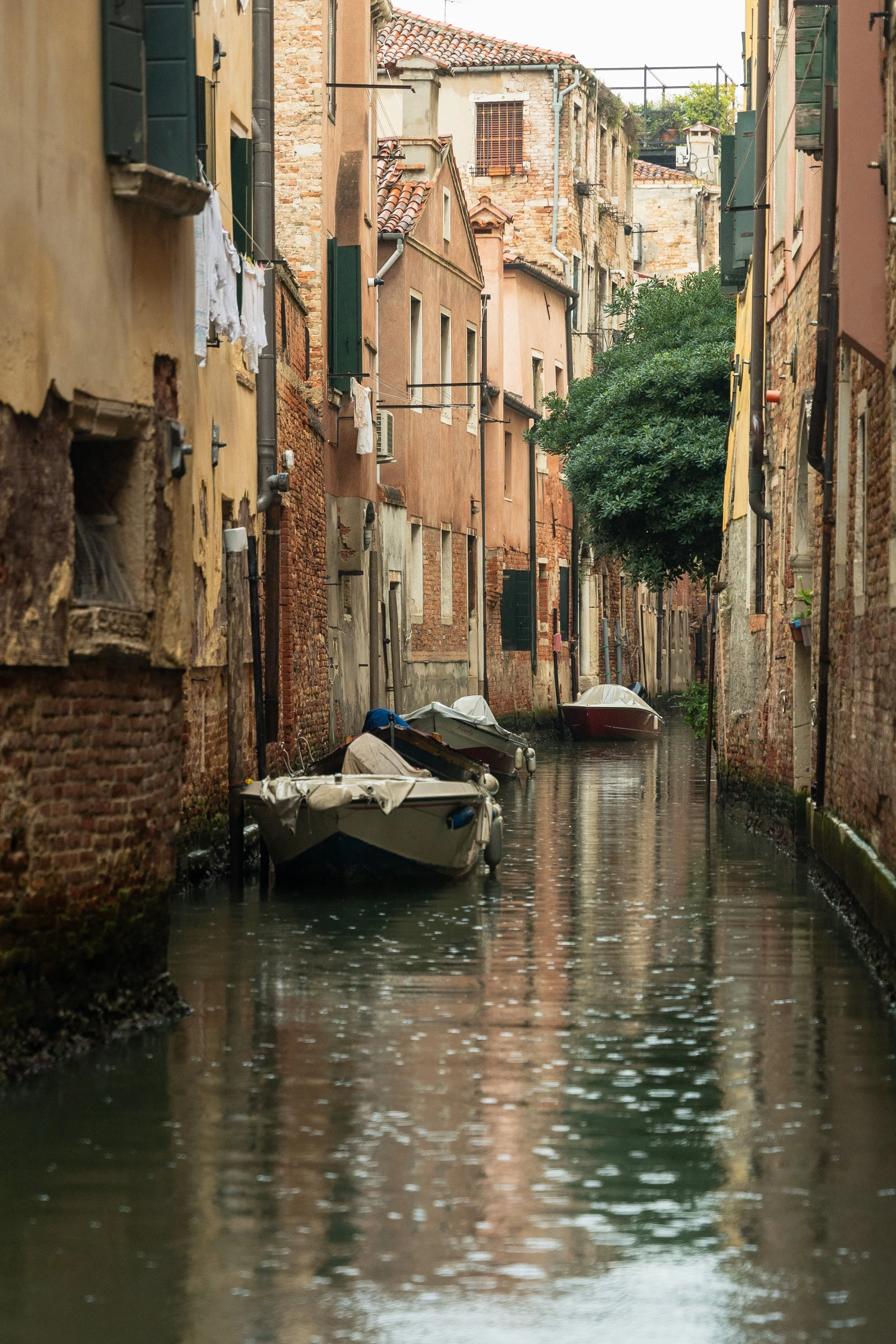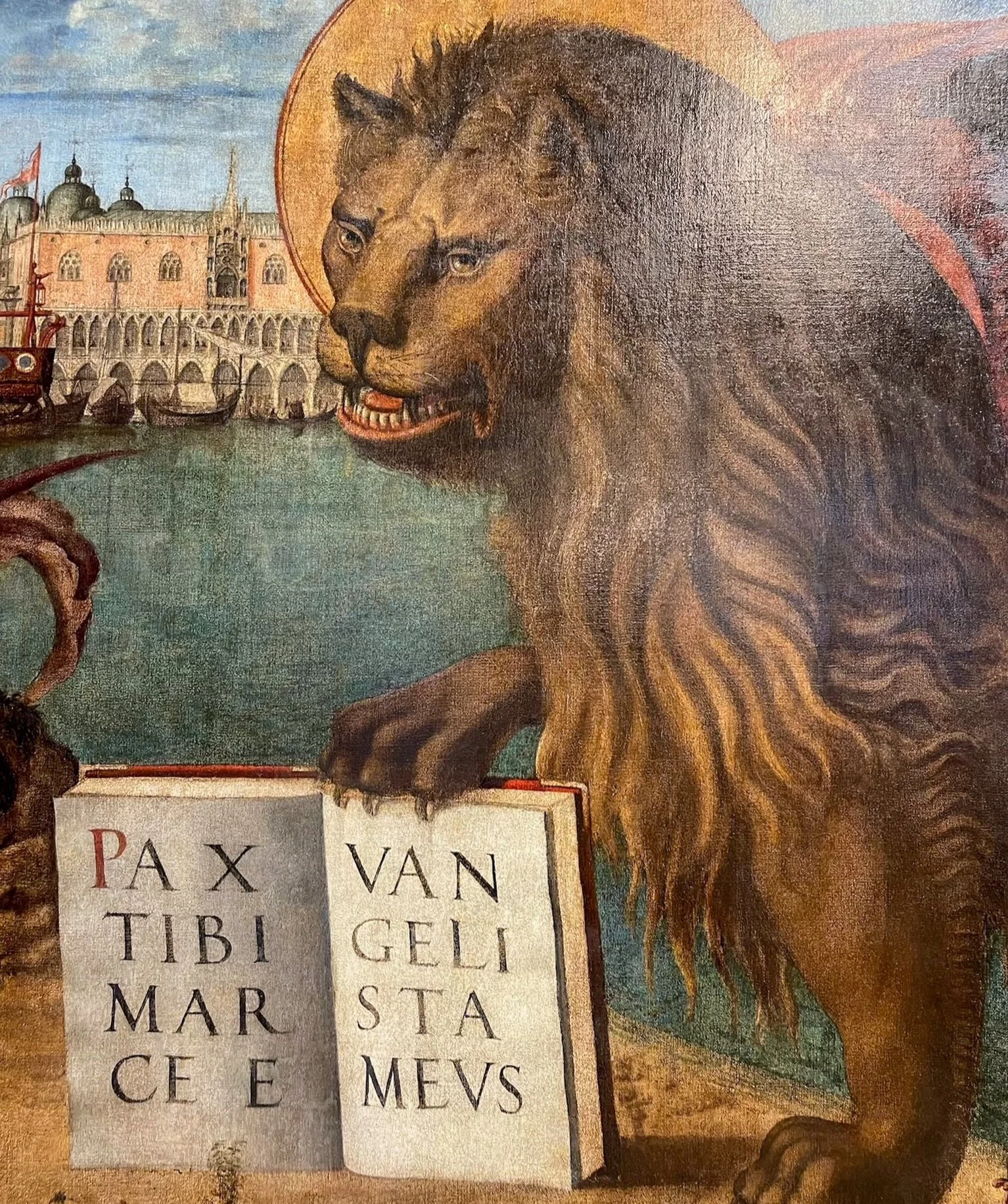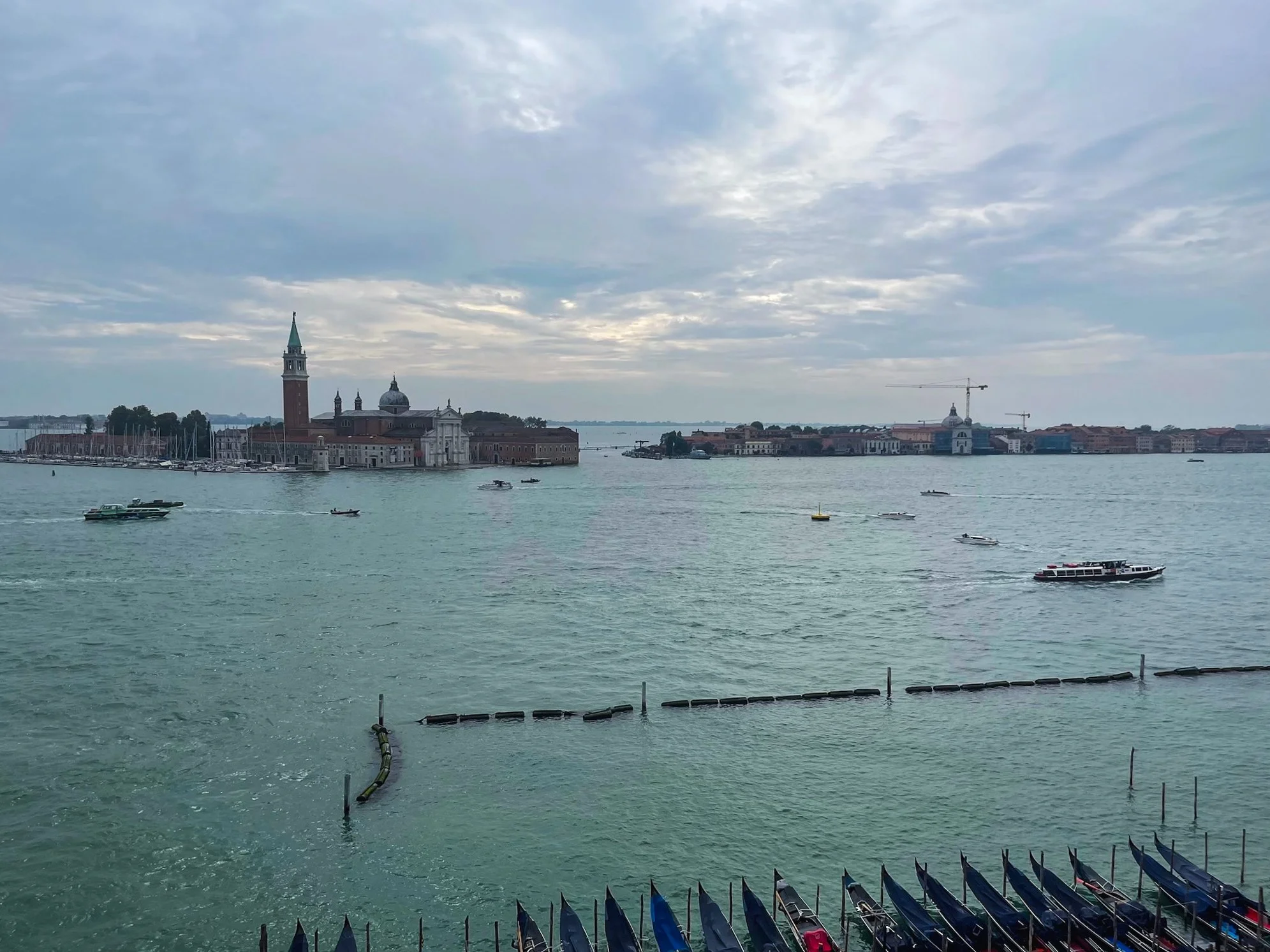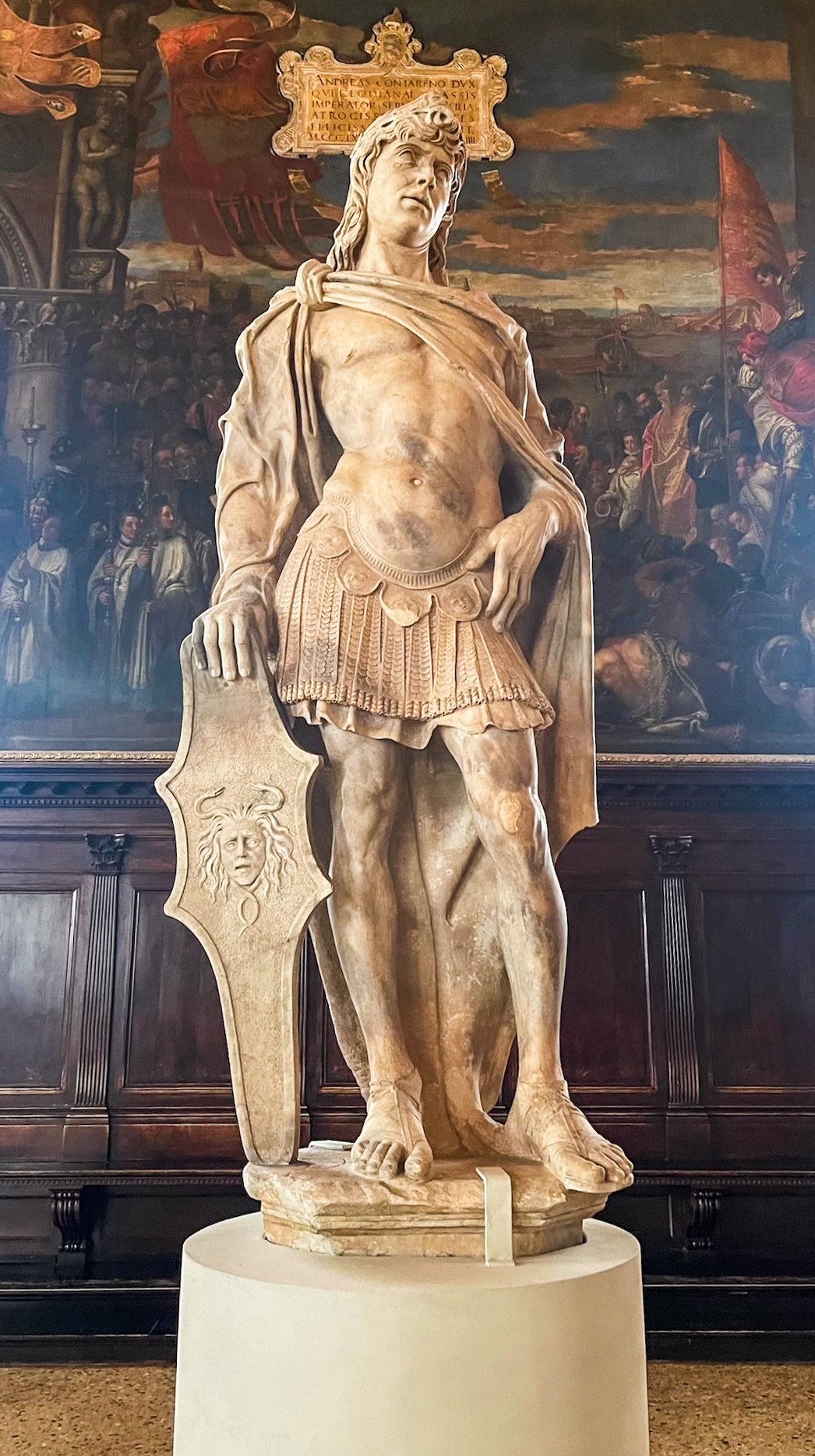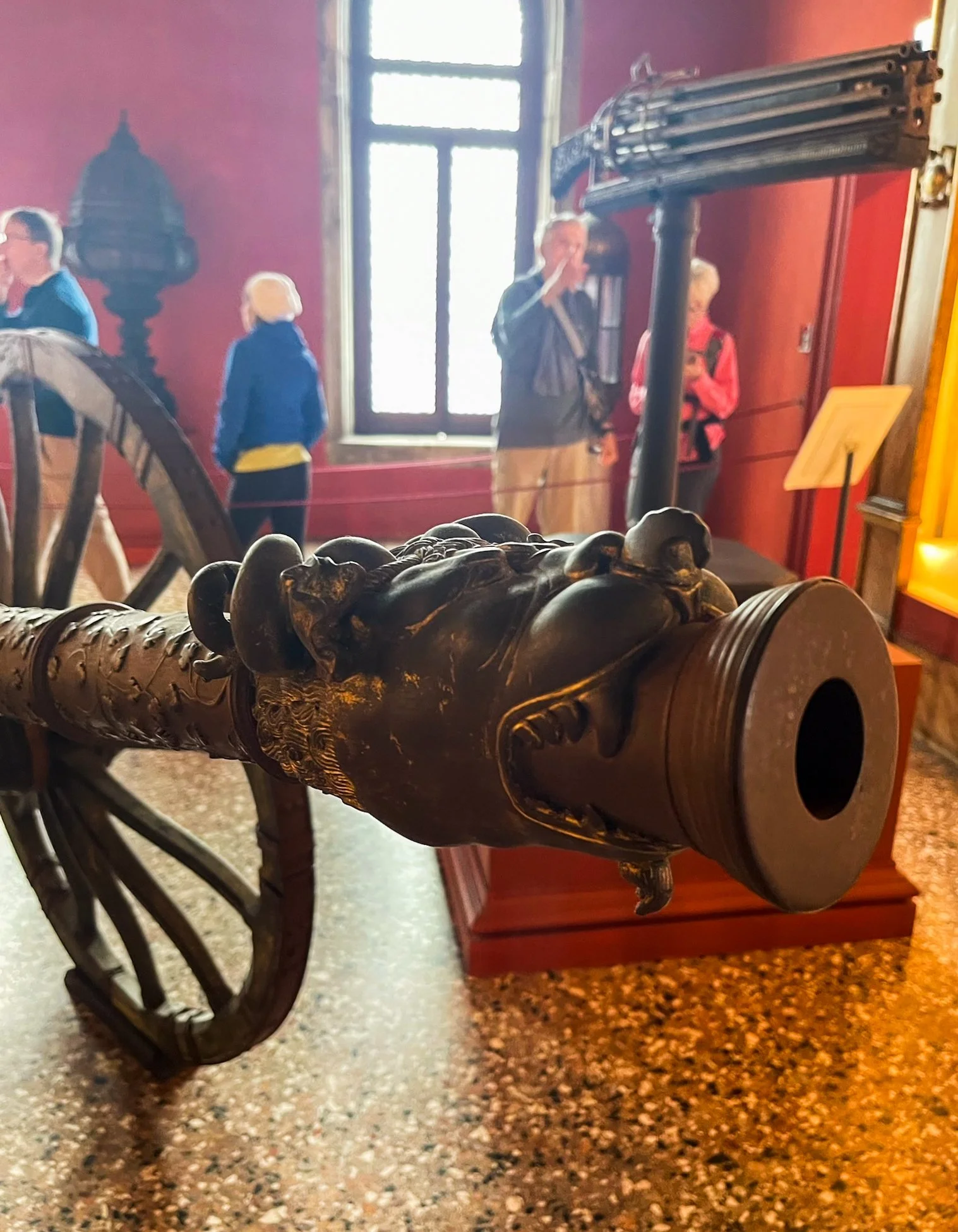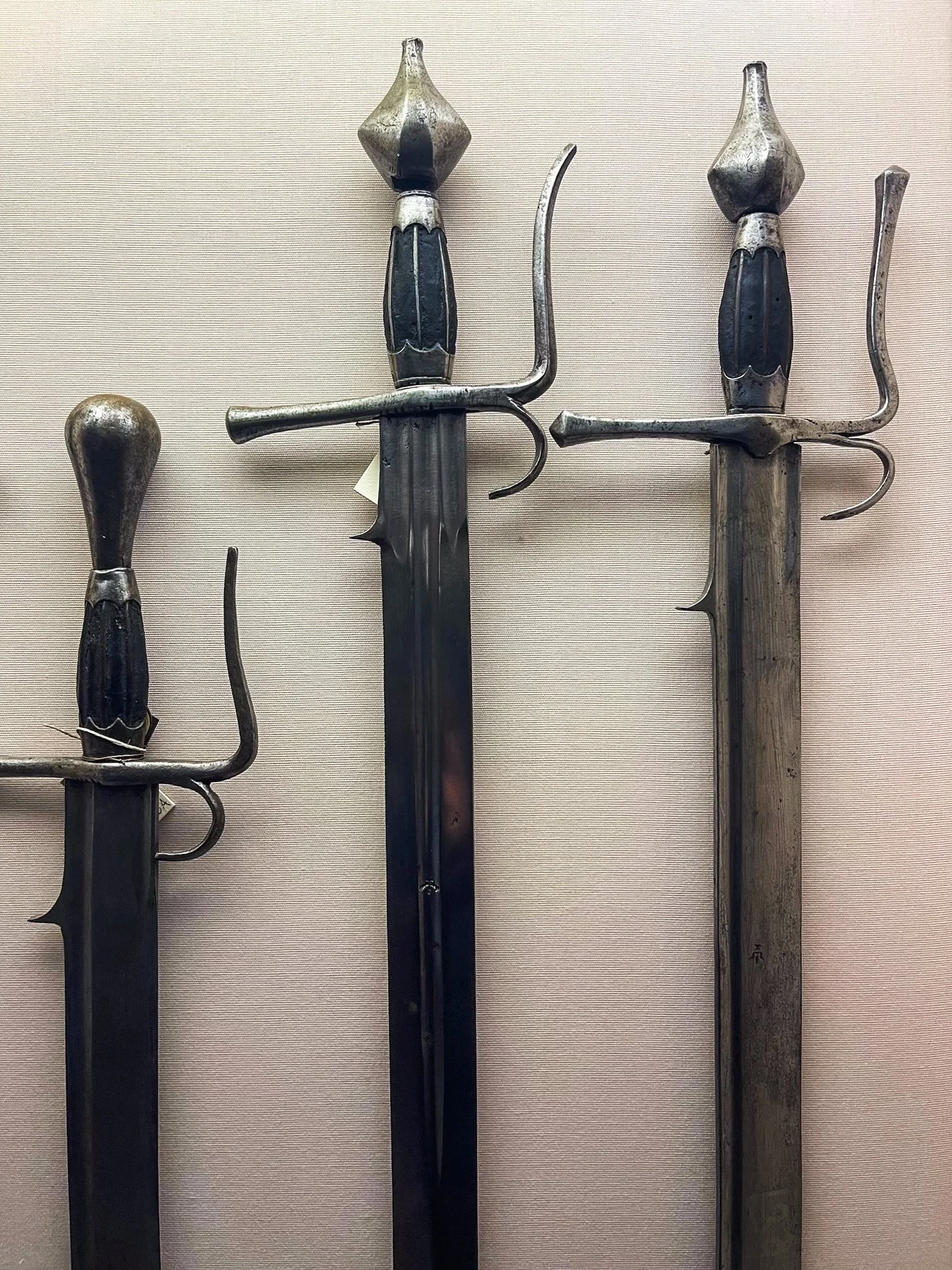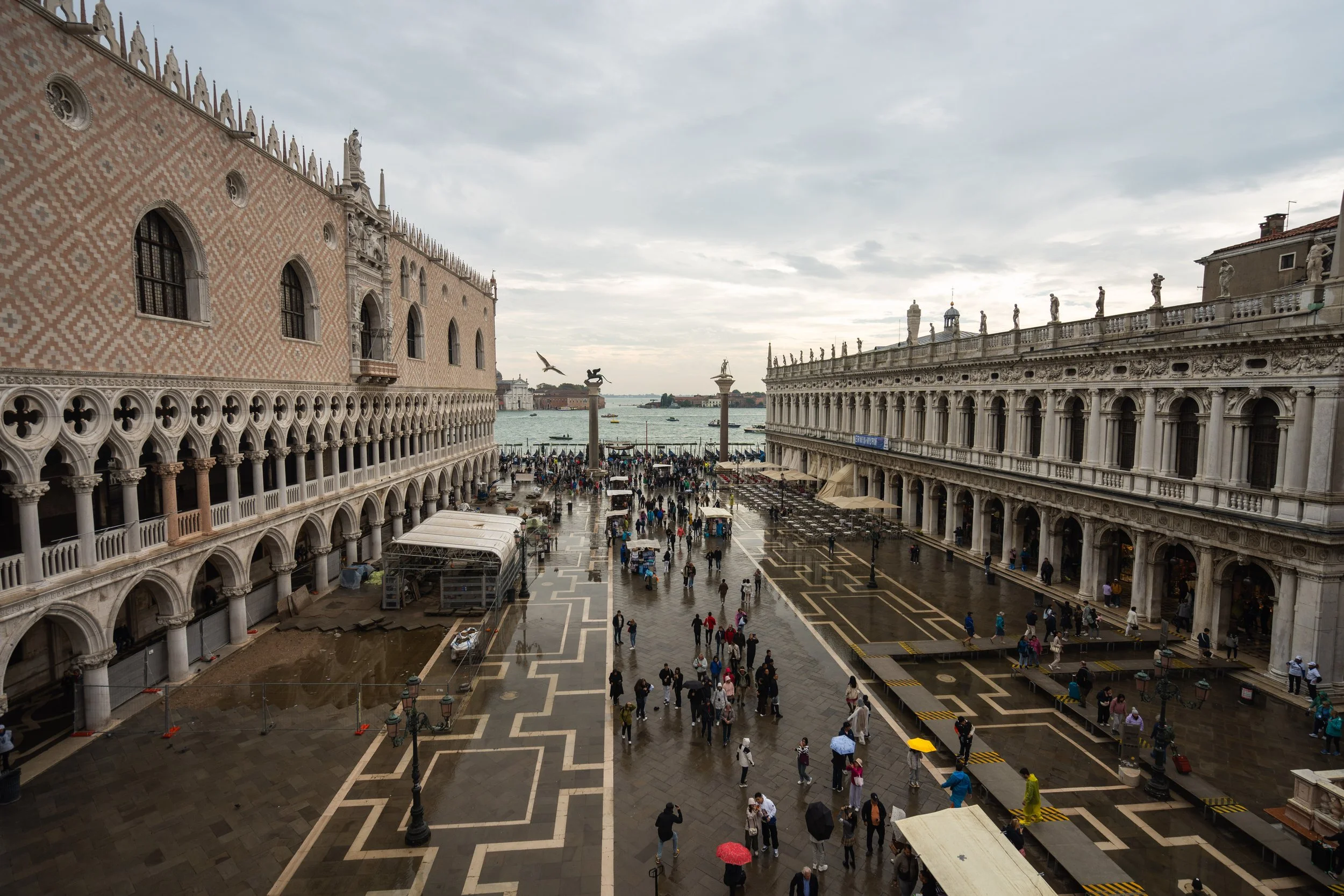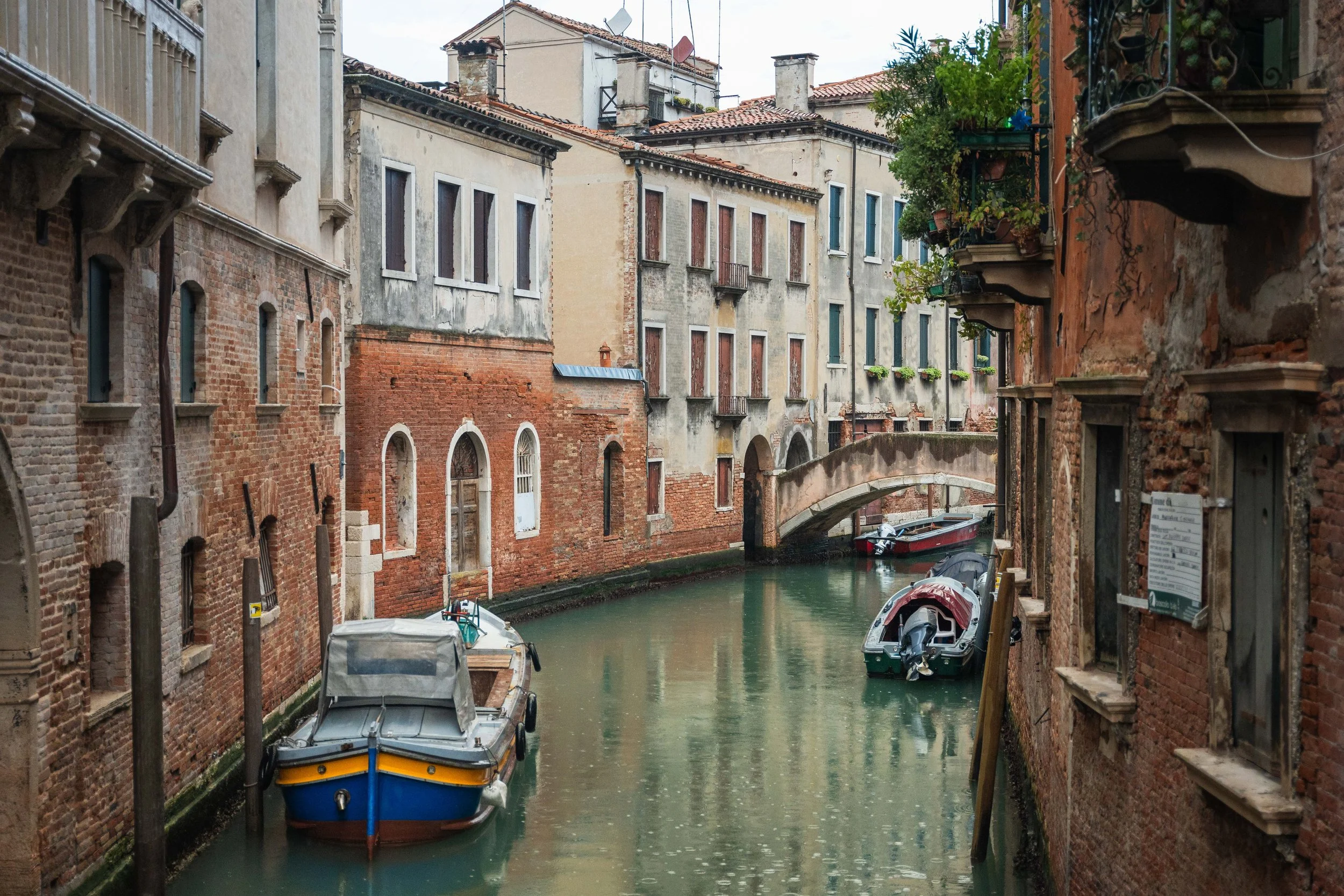My Way Italy Day 1-2: Cruising the Canals of Venice
After a four-hour train ride from Rome, we arrived in Venice — not just a city, but a world unto itself. It felt like that moment in The Empire Strikes Back when Han, Leia, R2-D2, and C-3PO arrived at Cloud City. One moment, you’re in the real world, and the next, you’re staring at something that doesn’t seem possible. No cars. No horns. Just the soft splash of oars cutting through water and the hum of vaporettos on the Grand Canal. Venice doesn’t slowly reveal itself — it hits you all at once. Gothic palaces rise straight from the water, weathered but proud, their faded pastels and crumbling grandeur reminding you that Venice is beautiful because it’s imperfect. Boats and gondolas drift past like actors in a centuries-old play, and for a moment, it feels like you’re standing in a dream you don’t want to wake up from.
This was the first stop on our Rick Steves’ Italian My Way Tour, and I knew right then that Venice was going to be different from every city I’d ever explored. It wasn’t about checking off tourist spots — it was about wandering and wondering. The maze of canals and alleyways offers no straight path, only twists, dead-ends, and narrow bridges that demand you embrace the detour. There’s no "seeing it all" here — just letting it consume you slowly, like a good meal. Venice doesn’t need to prove itself. It just is.
Overview
-
Doge’s Palace: A grand Gothic-style palace that once served as the residence of the Doge, as well as the city’s political and administrative center. It now functions as a museum housing council chambers, masterpieces by Venetian artists, and a route over the Bridge of Sighs to the adjacent prison cells.
Tickets are €30 and can be purchased 30 days in advance.
St. Mark’s Basillica: known for its Byzantine architecture and lavish mosaics depicting religious scenes. Constructed as a symbol of Venetian wealth and power, it houses the relics of St. Mark, the city’s patron saint making it one of the most iconic and visited churches in Italy.
We purchased tickets on-site before entering the Basilica which were about €3.
St. Mark’s Square: This is the heart of Venice and a grand public space famous for its monumental architecture including St. Mark’s Basilica and the Doge’s Palace. It has long been a gathering place for public events and a symbol of Venetian civic life.
Bridge of Sigh’s: This famed enclosed bridge connects Doge’s palace with Prigioni Nuove (New Prisons). This was appropriately named because it would provide prisoners their last glimpse of the outside world and of freedom.
If you plan on visiting Doge’s palace this will likely be included in your ticket.
Ponte di Rialto: Famed for it’s elegant arched design this is the oldest and most iconic bridge crossing the Grand Canal connecting San Marco and San Polo.
Canals and Gondolas: Venice is a city built in the lagoons of the Adriatic Sea. This city doesn’t have streets filled with cars—only canals where gondolas and boats serve as the main form of transportation.
Gondola rides cost about €80 during the day and €100 after 7 pm.
-
Ristorante Al Theatro: Tucked behind Venice’s La Fenice Theater, celebrated for its refined Venetian cuisine and fresh, locally sourced ingredients and seafood.
Trattoria Pizzería Da Gioia: Tucked away on a narrow street this is a great place to grab a quick lunch, especially if you’ve spent the morning exploring St. Mark’s Basilica and Doge’s Palace.
Bar e Caffè Vasti: This is a great option if you need an afternoon caffeine boost while exploring the San Polo neighborhood.
Ristorante - Pizzeria da Roberto: After a full day exploring Venice this was a great place to stop and enjoy a glass of wine or a beer and watch gondolas glide silently past you.
Vino Vino: This is a cozy wine bar and restaurant known for its great wine selection and relaxed atmosphere making it a popular spot to unwind and sample authentic flavors in an intimate setting.
-
Venice is best explored either early in the morning before cruise ship passengers arrive for the day or after they leave.
The city is a labyrinth of canals and alleyways and is best explored on foot and it’s a great place to get lost. The best parts of the city are best found the further you get from St. Mark’s Square. To see the city by water you can take a gondola ride or vaporetti.
My Way Italy Day 1: Arrive in Venice
Cruising the Grand Canal
Most cities are defined by their famous streets — New York has Broadway, Los Angeles has Hollywood Boulevard, and London has Abbey Road. But Venice isn’t like most cities. Here, there are no streets, only canals. The most iconic of them all is the Grand Canal — a 2.4-mile-long, 295-foot-wide aquatic artery that snakes through the heart of the city.
Instead of buses, Venice runs on boats. Public transit here isn’t a screeching subway or a lumbering bus — it’s a vaporetto gliding over water. On our first day, we hopped aboard one and rode the length of the Grand Canal. For 35 minutes, we floated past grand villas and centuries-old palazzos, their facades weathered but proud, standing tall against the tide. It wasn’t just transit — it was a front-row seat to Venice’s timeless beauty.
Our journey down the Grand Canal ended at St. Mark’s Square, home to the majestic Doge’s Palace and the awe-inspiring St. Mark’s Basilica. The sheer grandeur of this place is impossible to ignore. Even centuries after its heyday, it remains the beating heart of Venice, drawing thousands of visitors each day. Crowds spill into the square, necks craned upward, eyes wide with wonder — just as travelers have done for generations.
After gliding past centuries-old palazzos and elegant villas on the Grand Canal, Venice had already exceeded every expectation. The city's beauty wasn’t subtle — it was bold, cinematic, and impossible to resist. By the time we stepped into St. Mark’s Square, I was fully hooked, ready to wander deeper into this legendary city and see what other marvels it had in store.
Gondola Ride at Night
After meeting our tour guide, Cary, and the rest of the group, we set off to explore Venice. It didn’t take long before we were delightfully lost in the maze of narrow alleyways. But in Venice, getting lost isn’t a mistake — it’s a privilege. Every turn reveals hidden courtyards, quiet canals, and glimpses of local life that most tourists never see.
As night settled over the city, we did what every visitor dreams of: we boarded a gondola. While most opt for a daytime ride, nighttime transforms the experience. The city quiets, the water turns to black glass, and Venice shows its moody, cinematic side. It felt like drifting through the Pirates of the Caribbean ride at Disneyland — except this was real. No animatronics, no speakers — just the creak of the oar, the echo of distant footsteps, and the lapping of water against ancient stone.
At night, the canals feel like yours alone. The crowds are gone, and for a moment, it felt like we’d slipped into the 15th century, moving unseen through the heart of the city. If you’re visiting Venice, a gondola ride is a must. Day, night, rain, or shine — it doesn’t matter. We went during a gray, rainy evening, and the reflections made it all the more magical. As a photographer and filmmaker, I can only imagine the beauty of golden hour on a crisp fall day. But truthfully, Venice looks stunning no matter the light — and on that gondola, it felt like Venice had saved its best version just for us.
“On a gondola, you glide through your own private Venice far from the hubbub of modern tourism. Lonely bridges, canals without sidewalks, and reflections of once-upon-a-time grandeur. ”
Taylor Tip
The best time to explore Venice like a local is in the morning before 8 am or later in the afternoon since you won’t have to compete with others who are just visiting for the day.
My Way Italy Day 2: Full Day in Venice
A Morning at Doge’s Palace: Power, Opulence, and the Weight of Captivity
We started our day at the Doge’s Palace, a Venetian masterpiece standing proudly next to St. Mark’s Basilica and St. Mark’s Square. Built in 1340, this iconic palace was once the seat of power for the Venetian Republic, serving as the home of the Doge — Venice's supreme leader. Today, it’s a museum, offering visitors a rare glimpse into the world of Venice's elite, where politics, wealth, and art collide in grand fashion.
Walking through the palace, it’s impossible not to be awestruck by the sheer level of opulence. Every room is a spectacle — walls covered in gilded trim, frescoes larger than life, and ceilings that seem to reach the heavens. The Grand Council Chamber left the biggest impression on me. This was where the powerful minds of Venice would gather to debate and dictate policies that shaped daily life for its citizens. It’s hard to stand in that room and not feel the weight of history pressing down on you.
What struck me most, as a photographer and filmmaker, was the sheer cinematic quality of the palace’s design. Every fresco, every mural, and every gilded frame seemed to tell a story through light, shadow, and composition. The use of bold colors, dramatic lighting, and larger-than-life figures reminded me of the principles I strive for in my work. The visual storytelling on these walls was pure drama — tension, triumph, and tragedy all playing out in vivid color. I found myself inspired, thinking about how I could bring that same sense of grandeur and depth into my future projects.
Before leaving, we crossed the Bridge of Sighs, a hauntingly beautiful passageway that connects the Doge’s Palace to the prison cells. It’s easy to romanticize it from the outside, but walking through it is a different experience altogether. Looking through the small, stone-barred windows, you can see the Venice lagoon below — a fleeting glimpse of freedom that was the last sight many prisoners ever had before being locked away in a cold, cramped cell. It’s called the Bridge of Sighs for a reason. I tried to imagine the weight those prisoners must have felt as they crossed it, knowing it might be the last time they’d see daylight. Seeing the bleak, claustrophobic prison cells on the other side only reinforced that feeling of dread. It’s no wonder Casanova — Venice’s most infamous rogue — hatched a daring plan to escape after more than a year in one of those cells. After seeing the conditions firsthand, I can’t blame him.
Visiting Doge’s Palace was more than just ticking off a tourist attraction — it was an immersion into Venice's history. It revealed the layers of power, politics, and humanity that shaped the city’s past. The art, the architecture, and even the shadows of the prison left me thinking about Venice in a whole new way. It’s one thing to admire a city from its streets, but walking through its palace is like flipping through the pages of its most dramatic chapters.
Saint Mark's Basilica: Venice’s Crown Jewel
After exploring the grandeur of Doge’s Palace, we made our way to St. Mark’s Basilica, one of Venice’s most iconic and enduring landmarks. This basilica is more than a place of worship — it’s a living testament to Venice’s wealth, power, and maritime dominance. Originally built in 828 AD to house the stolen relics of St. Mark the Evangelist, the current basilica was completed in 1094 and has since been expanded and embellished over the centuries, each generation adding new layers of beauty and meaning.
The first thing that struck me was the unmistakable Byzantine architecture. The basilica’s five onion-shaped domes, grand arches, and intricate stonework give it an otherworldly presence. It’s the kind of building that demands a second, third, and fourth glance. The exterior alone is enough to leave you in awe, but nothing prepares you for what waits inside.
Stepping through the doors felt like walking into a glowing, golden world. Mosaics cover nearly every surface — ceilings, walls, and domes shimmer with scenes from the Bible, moments from St. Mark’s life, and grand depictions of Venetian history. Each tiny tile of glass and gold reflects the light, making the entire interior feel alive with movement. It’s like being inside a giant, illuminated manuscript. The colors, the craftsmanship, and the sheer scope of the work are staggering. It’s not just art — it’s a story told in gold.
But St. Mark’s Basilica isn’t just beautiful — it’s symbolic. Every mosaic, every relic, and every architectural detail was designed to broadcast Venice’s power to the world. This wasn’t just a house of worship; it was a statement. It showed that Venice could not only rival the splendor of Constantinople but, in some ways, surpass it. The basilica stands as a reminder that Venice was once a maritime superpower whose influence stretched from the Adriatic to the shores of the Middle East.
The rising tides of the Acqua Alta
Venice isn’t just famous for its canals — it’s also slowly sinking into them. I’d heard about it before, but seeing it firsthand made it feel real. It’s not just centuries of settling into marshy ground — rising sea levels and climate change have turned a slow problem into a looming crisis.
Nowhere is this more obvious than St. Mark’s Square, which floods daily like clockwork. In the morning, it’s dry. By midday, it’s a shallow wading pool. Raised walkways appear so pedestrians can avoid the water, but navigating them feels like walking a crowded balance beam.
What surprised me most was how little it disrupted daily life. Restaurants stayed open, musicians played on, and waiters served meals with rubber boots peeking out from under their aprons. Venice isn’t just enduring the water — it’s defying it. But watching it all unfold, it’s clear that without bold solutions, water may one day win.
Afternoon Exploring Venice
In the afternoon, we left behind the crowds and luxury storefronts of Venice’s tourist core and wandered deeper into the city's quieter neighborhoods. This is where Venice feels most authentic — where Venetians actually live. Here, we strolled past weathered apartment buildings with laundry strung between windows, the kind of homes where families have lived for generations. Small mom-and-pop shops lined the alleys, exuding a warmth and charm that big-name brands can’t fake. It’s here that Venice stops feeling like a movie set and starts to feel like a real, living city.
At one point, we ducked into a café for an afternoon coffee. As the rain gently tapped on the windows, we watched kids heading home from school, backpacks swaying behind them, while locals hurried past, umbrellas in hand, eager to get inside. It felt like being let in on a quiet secret — a glimpse of Venice that most tourists never see.
Wandering the maze-like alleyways was an adventure all its own. Every turn felt like a roll of the dice — one moment you’re standing outside a tiny, family-run trattoria where the smell of simmering tomato sauce seeps into the street; the next, you’re in front of an ancient basilica where Venetians have worshiped for over 500 years. Each discovery was a small reward for letting curiosity lead the way.
With only a short time to explore Venice, I’m convinced that stepping beyond the big tourist sights gave me a richer, more personal experience of the city. The slower pace, the quiet moments, and the human details are what will stay with me long after I’ve left. It’s this philosophy that makes Rick Steves’ tours stand out — he and his guides don’t just show you the big highlights; they invite you to get lost on purpose. And in Venice, that might just be the best way to see it.
It’s easy to say it was hard to leave Venice. After just a day and a half, the city had already left its mark on me. I fell in love with its winding alleyways, the quiet splash of gondolas gliding through narrow canals, and the sense that every turn might lead to something unexpected. But what made it truly special was sharing it with my parents and brother. Exploring together, getting lost together, and making memories that will outlast the trip itself — that’s what I’ll remember most.
Late in the afternoon, about 45 minutes before sunset, we found a small bistro near our hotel and sat down for a well-earned beer. The sky was still cloudy, but the fading daylight gave the city a soft, but the light from restaurants and shops gave it a golden glow. The rain had finally stopped, leaving the streets slick with reflections of the glowing streetlights. Gondolas floated by like shadowy specters. The cruise ship crowds had thinned, and for the first time all day, the city felt like it belonged to us. Without the crush of tourists, we could finally slow down, breathe it all in, and savor the moment.
There’s a charm to Venice as the day winds down that’s hard to describe. During the day, it can feel like you’re on a conveyor belt of tourists, shuffling from one landmark to the next. But as the sun dips lower and the crowds begin to fade, Venice feels different. You’re free to wander at your own pace, free to look around without clutching your bag or dodging pickpockets. It’s at this time that Venice reveals its true magic.
Looking back, Venice stands out as one of the most unique places I’ve ever visited. No cars, no streets — just canals, cobblestones, and an endless maze of alleys. I loved getting lost in those alleys, never knowing if I’d stumble onto a quiet piazza, a café filled with locals, or a tiny flower shop spilling its blooms onto the street. It’s a city that rewards curiosity. A day and a half was nowhere near enough, and I’m already thinking about the next time I can return. There’s more of Venice waiting to be found — and I plan to find it.
Taylor Tip
To see how locals live in Venice, venture deeper into the city and get away from tourist hotspots like St. Mark’s Square and the Rialto Bridge.


